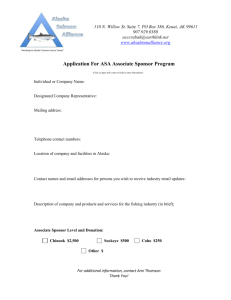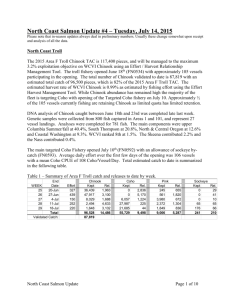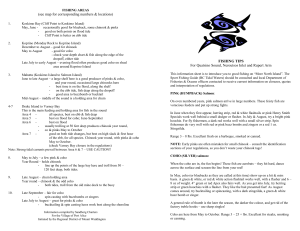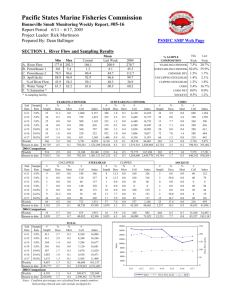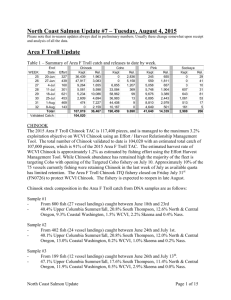15 08 11 North Coast Salmon Update
advertisement
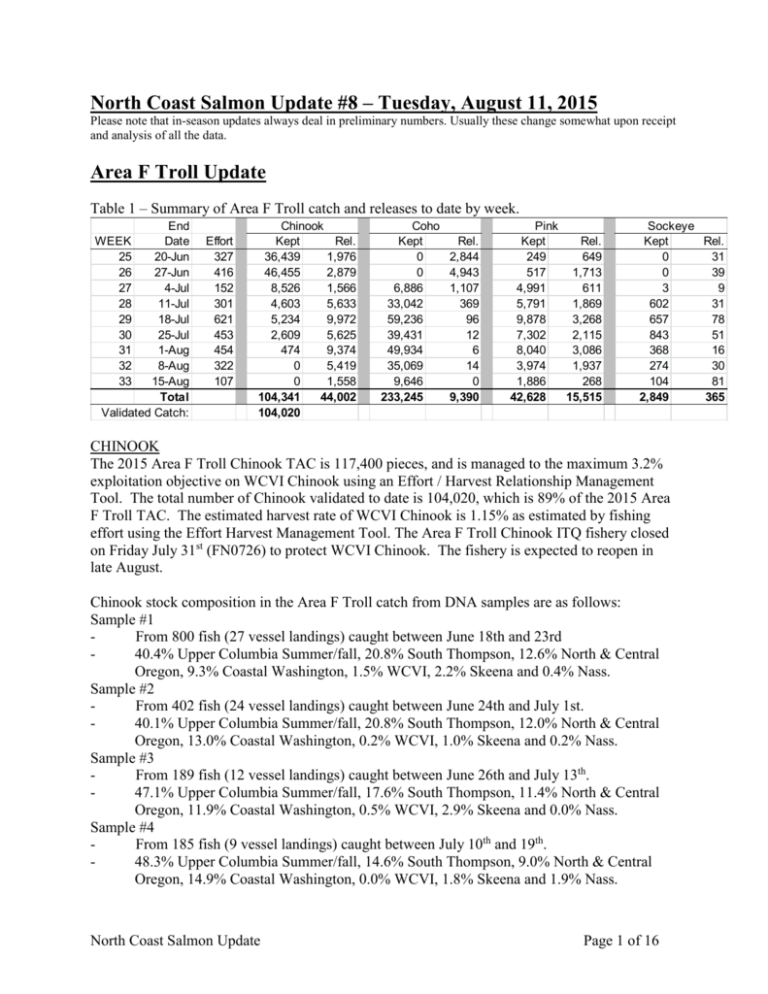
North Coast Salmon Update #8 – Tuesday, August 11, 2015 Please note that in-season updates always deal in preliminary numbers. Usually these change somewhat upon receipt and analysis of all the data. Area F Troll Update Table 1 – Summary of Area F Troll catch and releases to date by week. End Date 20-Jun 27-Jun 4-Jul 11-Jul 18-Jul 25-Jul 1-Aug 8-Aug 15-Aug Total Validated Catch: WEEK 25 26 27 28 29 30 31 32 33 Effort 327 416 152 301 621 453 454 322 107 Chinook Kept Rel. 36,439 1,976 46,455 2,879 8,526 1,566 4,603 5,633 5,234 9,972 2,609 5,625 474 9,374 0 5,419 0 1,558 104,341 44,002 104,020 Coho Kept 0 0 6,886 33,042 59,236 39,431 49,934 35,069 9,646 233,245 Rel. 2,844 4,943 1,107 369 96 12 6 14 0 9,390 Pink Kept Rel. 249 649 517 1,713 4,991 611 5,791 1,869 9,878 3,268 7,302 2,115 8,040 3,086 3,974 1,937 1,886 268 42,628 15,515 Sockeye Kept Rel. 0 31 0 39 3 9 602 31 657 78 843 51 368 16 274 30 104 81 2,849 365 CHINOOK The 2015 Area F Troll Chinook TAC is 117,400 pieces, and is managed to the maximum 3.2% exploitation objective on WCVI Chinook using an Effort / Harvest Relationship Management Tool. The total number of Chinook validated to date is 104,020, which is 89% of the 2015 Area F Troll TAC. The estimated harvest rate of WCVI Chinook is 1.15% as estimated by fishing effort using the Effort Harvest Management Tool. The Area F Troll Chinook ITQ fishery closed on Friday July 31st (FN0726) to protect WCVI Chinook. The fishery is expected to reopen in late August. Chinook stock composition in the Area F Troll catch from DNA samples are as follows: Sample #1 From 800 fish (27 vessel landings) caught between June 18th and 23rd 40.4% Upper Columbia Summer/fall, 20.8% South Thompson, 12.6% North & Central Oregon, 9.3% Coastal Washington, 1.5% WCVI, 2.2% Skeena and 0.4% Nass. Sample #2 From 402 fish (24 vessel landings) caught between June 24th and July 1st. 40.1% Upper Columbia Summer/fall, 20.8% South Thompson, 12.0% North & Central Oregon, 13.0% Coastal Washington, 0.2% WCVI, 1.0% Skeena and 0.2% Nass. Sample #3 From 189 fish (12 vessel landings) caught between June 26th and July 13th. 47.1% Upper Columbia Summer/fall, 17.6% South Thompson, 11.4% North & Central Oregon, 11.9% Coastal Washington, 0.5% WCVI, 2.9% Skeena and 0.0% Nass. Sample #4 From 185 fish (9 vessel landings) caught between July 10th and 19th. 48.3% Upper Columbia Summer/fall, 14.6% South Thompson, 9.0% North & Central Oregon, 14.9% Coastal Washington, 0.0% WCVI, 1.8% Skeena and 1.9% Nass. North Coast Salmon Update Page 1 of 16 Total estimated catch of WCVI Chinook (based on DNA analysis of catch) is 1,100 pieces. COHO The main targeted Coho Fishery opened July 10th (FN0592) with an allowance of sockeye bycatch (FN0593). Average daily effort over the last week was 62 vessels with a mean Coho CPUE of 108 Coho/Vessel/Day. Total catch to date is estimated to be 233,000 Coho, 42,600 Pinks and 2,800 Sockeye. Area F Troll closed to the retention of sockeye on August 7th (FN0780) to avoid interception of Fraser Sockeye. A comparison of Coho CPUE over the past decade and fleet distribution are depicted in the following graphs. Figure 1 Mean Weekly Catch Per Unit Effort (CPUE) in Area F Troll. CPUE = (# Coho Caught + # Coho Released) / Vessel / Day. North Coast Salmon Update Page 2 of 16 Figure 2 – Distribution of fishing effort of the Area F Troll Fleet by week. North Coast Salmon Update Page 3 of 16 Area 1-2 Recreational Recreational catch estimates for the month of July are not expected until next week. Table 2: Estimated Area 1-2 Recreational Catch to the end of June 2015 Month May June May June % of total catch by source Note: Season Catch By Species Area Coho Chinook Pink Sockeye Chum Rockfish 1 40 500 5 1 5 150 2E 0 400 0 0 0 0 2W 20 100 0 0 5 250 May Total 60 1000 5 1 10 400 1 1800 8200 50 20 80 1900 2E 0 150 0 0 0 100 2W 700 3200 60 0 10 3400 June Total 2500 11550 110 20 90 5400 1 1840 8700 55 21 85 2050 2E 0 550 0 0 0 100 2W 720 3300 60 0 15 3650 Season Total: 2560 12550 115 21 100 5800 Log Book 88% 86% 98% 86% 98% 95% Creel 7% 8% 0% 0% 0% 2% Estimate 4% 5% 2% 14% 2% 3% Catch estimates are preliminary and subject to change. Data sources include Logbook program from fishing lodges, Haida Creel and anecdotal information Halibut 150 200 100 450 3400 300 1500 5200 3550 500 1600 Lingcod 75 0 125 200 1300 50 1600 2950 1375 50 1725 5650 82% 7% 11% 3150 92% 3% 5% Figure 3: Catch and releases of Coho and Chinook in Area 1. Figure from Haida Fisheries Program June Creel Report. North Coast Salmon Update Page 4 of 16 Southeast Alaska Troll Regional coho CPUEs remain slightly above the 20-year average, though effort is below average. Southeast Alaska Southern Inside Troll Coho Catch per Boat-Day Tree Point Gill Net Fishery The Tree Point gill net fishery in Alaska was extended to 4 days of fishing this week, opening Sunday, August 9th, at noon, and closing at noon on Thursday, August 12th. No catch estimates were available for this opening at the time of posting. Catch estimates for the previous week (Week 32) for the Tree Point gill net fishery are listed below. Week 32 gill net (August 2 - 8) harvests for 42 vessels over 4 days fishing: Chinook Sockeye Coho Pink Chum 20 2,500 1,400 51,000 35,000 Noyes Island Seine Fishery The District 4 seine fishery opened for 39 hours this week, from 05:00 Tuesday, August 11th to 20:00 on August 12th. No catch estimates for this opening were available at time of posting. Catch estimates Week 32B (August 7th/8th) are listed below. Week 32B SN harvests for 42 vessels: Chinook Sockeye 5,100 72,000 North Coast Salmon Update Page 5 of 16 Coho Pink Chum 7,800 650,000 29,000 Area 3 (Nass River) The Nass River fishwheels have been operating since June 4th. The current in-season total return to Canada (TRTC) forecast (50% confidence interval), based on mark-recapture data and mean run timing, increased from 567,000 last week to 607,000 (561,000 – 775,000) for data to August 9th. This estimate assumes that 88% of the returning sockeye have migrated past the lower fish wheels at Gitwinksihlkw. The in-season run-size estimate past the Gitwinksihlkw fishwheels (GW), for data to August 9th, is 331,057 sockeye, much higher than the 1994-2014 average of 238,000. The run-size target past the GW fishwheels is 250,000 sockeye. In addition, the point estimate for Nass chinook TRTC dropped slightly from 38,000 last week to 37,000 (36,000 – 40,000), based on mark-recapture data and mean run timing, and assuming that 97% of the returning stock has migrated past the GW fishwheels. The in-season run-size estimate past the GW fishwheels for upper Nass chinook , for data to August 9th, is 26,500 fish, much higher than the 1994-2014 average of 20,000. The run-size target past the GW fishwheels is 15,000 chinook. For coho, assuming that 26% of the run has migrated past the GW fishwheels, the TRTC estimate is 181,000 (100,000 – 479,000). Meanwhile, the odd-year pink TRTC estimate is 632,000 (187,000 – 723,000), assuming 36% of the run has migrated past the GW fishwheels. At 1.6 meters, the Nass River water level at the GW fishwheels is 0.3 meters lower than the 1994 – 2014 average, while water temperature at the same location remains 10.0oCelsius, which is equal to the 1994 – 2014 average. http://www.pac.dfo-mpo.gc.ca/fm-gp/northcoast-cotenord/nass-eng.htm Nisga’a Fisheries Below is the estimated catch by Nisga’a harvest fisheries. To date, there have been 11 Nisga’a marine Individual Sales fisheries and 8 in-river Individual Sales fishery. At this time, Nisga’a Fisheries has announced that there will be no further in-river IS opportunities for sockeye and that further opportunities will be directed at coho. *From Nisga’a Fisheries North Coast Salmon Update Page 6 of 16 Commercial Net Fisheries: Twenty-five gillnet openings have occurred in Area 3. Further opportunities for later this week will be based on stock assessment information and will again be restricted in area to minimize interception of Skeena sockeye and Area 3 chum encounters, and operated under a nonpossession / non-retention regulation for chum and steelhead. Area 3 Gillnet Catch Estimates There have also been 13 seine opening to date, the last opportunities being Thursday July 30th and Friday’ July 31st to target Area 3 pinks and with retention of sockeye and coho. The fishery has been closed since due to poor pink abundance. Further opportunities will be based on pink abundance and will again be restricted in area to minimize interception of Skeena sockeye and Area 3 chum encounters, and operated under a non-possession / non-retention regulation for chum, chinook and steelhead. Area 3 Seine Catch Estimates to July 31st: A catch monitoring program is in place for Area 3 net fisheries. Packer vessels and gillnet vessels landing to shore-based sites each have a 20% chance of being validated by an independent service provider. At-sea observers are now being deployed to the fleet to gather non-target species release information. North Coast Salmon Update Page 7 of 16 Gillnet species composition from gill net validated landings Date Fished 09-Jun June 15/16 June 22/23 June 25/26 June 29/30 July 9/10 July 14/15 July 17/18 July 26/27 July 31/August 1 August 3/4 Sockeye Sockeye pieces % 459 2317 1702 2217 4209 8179 6806 7016 8,356 7,081 3,738 Pink pieces 100 98.8 78.8 89.7 86.9 44 39.8 27.1 27.9% 37.2% 61.9% Pink % 0 0 0 0 68 3.2 91 3.7 507 10.5 7953 42.8 8013 46.9 12618 48.7 20,745 69.4% 11,262 59.1% 2,003 33.2% Chum pieces 0 0 0 0 0 2206 2041 5863 2 0 0 Chum % Coho pieces 0 0 0 0 0 11.9 11.9 22.6 0.0% 0.0% 0.0% 0 4 292 114 24 220 203 403 770 690 293 Coho Chinook Chinook Steelhead % pieces % pieces 0 1.2 13.5 4.6 0.5 1.2 1.2 1.6 2.6% 3.6% 4.9% 0 0 97 49 106 21 27 22 39 27 6 0 0 4.5 2 2.2 0.1 0.16 0.09 0.1% 0.1% 0.1% 0 0 0 0 0 0 0 0 0 0 0 Steelhead % 0 0 0 0 0 0 0 0 0.0% 0.0% 0.0% Data provided by Ecotrust Canada Nass Inland Demonstration Fishery Both the Nisga’a and the Gitanyow are participating in inland demonstration fisheries to fish selectively for sockeye in the Nass watershed this year. The Nisga’a paused their harvesting from July 29-August 4 reduce impacts to Kwinageese sockeye but have since harvested the complete allocation of 5,154 sockeye. The Gitanyow continue their harvest at the Meziadin site and currently have 596 pieces remaining on their current allocation of 8,021 sockeye. Further sockeye allocations will be issued to both groups early next week, based on Area 3 marine commercial gillnet fishery catches. Sockeye allocations and Catches to date: First Nation # GN Licences Allocation Nisga’a 45 5,154 Gitanyow 55 8,617 Catch 5,154 8,021 Meziadin Fishway The Meziadin Fishway has been operational since July 1st. Current environmental conditions include water temperature of 17.5oCelsius, which is the same as the mean, and water levels which are near normal. As of August 9th, 84,184 adult sockeye (1994 – 2014 average to date is 91,000), 843 jack sockeye and 41adult chinook have passed through the fishway. All of these counts are below the 1994 – 2014 average, to date. Historic and 2015 counts are available here: http://www.pac.dfo-mpo.gc.ca/fm-gp/northcoast-cotenord/meziadin-eng.htm Kwinageese Weir The Kwinageese weir is being managed by the Nisga’a Fish and Wildlife department, and has been operational since July 3rd. As of August 9th, a total of 752 chinook and 333 sockeye had passed through the weir. Though sockeye counts are near half the 1994 – 2014 average to date, chinook numbers are more than double the average. No coho have been observed this year. Water levels and temperature are higher than normal for this time of year. North Coast Salmon Update Page 8 of 16 According to the Nisga’a Fish and Wildlife Department, “The lower Kwinageese River barrier site was visited on March 3, 2015. Water levels were higher than normal due to early snow melt. The crew observed that several of the concrete blocks that were previously placed in the thalwag of the channel have since washed out. The concrete weir was still functioning by pooling water at the base of the bedrock barrier. Crew visited the barrier site on July 23 under normal water level and observed that the concrete weir structure was in the same condition as when visited in 2014. Numerous chinook were observed holding in the pool below barrier and a few were observed jumping the barrier.” Area 4 (Skeena River) The pre-season Skeena sockeye run size was for an above average return of 3.5 million (50% probability) with a 90% probability of 1.7 million and a 10% probability of 7.3 million, based on the sibling model. Based on the estimated escapement past the Tyee Test Fishery to August 3rd, and assuming average run timing, the current in-season point estimate (50% probability) for Total Return to Canada increased to 1.04 million, with a 90% probability of at least 770,000 and a 10% probability of 1.32 million. As a result, no scheduled commercial Area 4 sockeye fisheries are anticipated at this time. The estimated Skeena sockeye escapement past the Tyee Test fishery, to August 10th, is 887,505 fish. Assuming average run timing, approximately 90% of the sockeye return should have passed the Tyee Test Fishery by August 10th. All species except sockeye and chinook are returning at, or above, historic decadal averages. Below is a graph of estimated Tyee sockeye escapement, by date, along with the Babine fence daily counts, delayed by 3 weeks (migration timing from Tyee to Babine), to provide information on relative run timing and daily abundance. 60,000 50,000 # of Fish / day 40,000 30,000 20,000 10,000 North Coast Salmon Update Page 9 of 16 2015 2015 2015 2015 2015 2015 2015 2015 2015 2015 2015 2015 2015 0 The steelhead index at Tyee is currently tracking above average, to date, when compared to data going back to the inception of the test fishery in 1956. Below is a graph of the cumulative steelhead index at Tyee, along with average and min/max values over that time frame. Supplied by Mark Beere, Min. of FLNRO. Tyee test fishery data are available here: http://www-ops2.pac.dfo-mpo.gc.ca/xnet/content/salmon/testfish/sockeye/tyee_gillnet.htm Tyee test fishery cumulative index to August 3rd: 2015 2000's Avg. 1990's Avg. 1980’s Avg. Sockeye 935.54 1654.10 1056.19 1432.94 Coho 25.80 25.13 16.29 31.29 Pink 511.45 607.28 411.09 588.38 Chum 23.50 14.23 20.93 23.02 Lg Chinook 136.61 269.58 203.81 169.28 Steelhead 76.84 71.44 59.35 71.01 Historical and 2015 counts are available here: http://www.pac.dfo-mpo.gc.ca/fm-gp/northcoast-cotenord/index-eng.html Net Fisheries: One 18 hour gillnet opening occurred on June 12 and a second opening of 30 hours on June 27/28. Both openings were directed on Skeena chinooks and catches were below average for both openings. Given the poor escapement of Skeena sockeye, to date, no commercial net opportunities on Skeena sockeye are anticipated in Area 4 at this time. North Coast Salmon Update Page 10 of 16 Area 4 Gillnet Catch Estimates Skeena Inland Demonstration Fishery The Lake Babine Nation and Gitxsan Watershed Authority have both expressed interest in participating in an inland demonstration fishery in the Skeena River watershed. Given the lack of commercial sockeye opportunities on Skeena sockeye to date, no inland demonstration fisheries on Skeena sockeye are anticipated at this time. Recreational Fisheries: The Area 3 and 4 marine creel survey began on June 1st. The preliminary data for estimated kept catch in June is listed below, along with historic June catch data (2009 – 2014) for comparison. Data for the July portion of the creel program will be available by August 15th. Estimated Kept Catch by Year Species 2015 2014 2013 2012 2011 Chinook 7,262 6,142 5,241 2,504 7,076 Coho 4,902 2,126 5,883 427 922 Chum 8 Pink 16 Sockeye 6 Halibut 3,823 3,346 3,781 2,363 5,105 * Note that 2015 data is still preliminary 2010 3,903 4,486 2009 4,840 3,813 3,494 3,083 The lower Skeena River creel survey began on June 1st. July results should be available next week. Regular daily retention limits apply for salmon in the Skeena watershed, except for sockeye salmon, which has been varied to 1/day. Kitwanga Fence An update was not provided in time for this week’s update. As such, preliminary data remains the same as last week’s information. The fence has been operational since July 10, which is the normal start date. The first chinook was counted on July 10th, with the total count of 160 as of the evening of July 29th. Assuming average run timing, ~14.7% of run has passed the fence by July 29th. North Coast Salmon Update Page 11 of 16 The first sockeye was counted on July 14th, with a total count of 26 to the evening of July 29th. Assuming average run timing, ~2.8% of run should have passed through the fence by July 29th. A single pink salmon and no chum or coho have migrated have passed through the weir, to date. Typically, the first pink and chum salmon arrive during the first week of August and the first coho arrive around the middle of August. Water levels are currently ~0.87m, slightly higher than normal. Since the last update daily water temperatures have been fluctuating between 12-15°C. http://www.pac.dfo-mpo.gc.ca/fm-gp/northcoast-cotenord/index-eng.html Babine River Counting Facility The first fish was counted through the Babine River fence on July 14th. Current daily water temperature at the facility ranges from 15.6– 16.5 Celsius, with water level increasing slightly to 87 cm on August 10th. Total counts to date include 292,088 large sockeye, 5,339 jack sockeye, 43 chinook, 45 jack chinook, 7,490 pinks and 26 coho. On average, 34% of large sockeye should have passed through the weir by August 10th. In addition, to date, 18% of the jack sockeye return should have migrated past the fence. The first recreational sockeye creel survey has been completed for Babine Lake, with data collected on August 1st and then on the August 8 & 9 weekend. Effort is down from historic values due to reduced retention limits and poor weather. The estimated catch (889) and daily angler CPUE (0.13 sockeye/angler day) are well below normal. Water temperature at Fulton on August 9th increased to 17.2oCelsius, with cooler temperatures and lots of rain on Monday. The first spawning has been observed in river and a few spawned out carcasses are evident. Enumeration of sockeye will begin next week. No update was provided for Pinkut Creek. Historical and 2015 counts are available here (updated today or tomorrow): http://www.pac.dfo-mpo.gc.ca/fm-gp/northcoast-cotenord/index-eng.html Slamgeesh Weir The Slamgeesh Salmon Project has been ongoing since the year 2000 in the Slamgeesh Watershed, Gitxsan traditional territory of Gwininitxw in the Upper Skeena watershed. The adult fence program was operational on July 27th and the first sockeye was caught on July 30th. To the night of August 9th, there has been 12 sockeye through the fence. Based on average run timing since 2001, typically 19% of the sockeye are through the weir. Currently water levels are higher than normal for this time of year but dropping and water temperature at the fence is ~ 17ºC. North Coast Salmon Update Page 12 of 16 The 2015 sockeye return is derived from brood years 2010 and 2011, which had 740 and 689 sockeye spawners respectively. For more information please contact: Alicia Fernando– Gitxsan Watershed Authorities afernando@gitksanwatershed.com Sustut Weir The Upper Sustut River weir has been in operation since August 1st . This is the 22nd year of operations. Two steelhead had passed through the weir as of noon on August 6th. No sockeye had been observed to that date. Area 6 Net Fisheries: Due to adequate chum abundance in the Kitimat River area, 4 directed chum gillnet opportunities have been provided in sub-area 6-1, August 3rd/4th and August 9th/10th. Catch information for all openings indicate good chum abundance. To date, the combined Area 6 gill net catch is estimated to be 52,166 chum, 1,059 pinks and 11 chinook. Releases included 244 sockeye 308 coho and 10 chinook. Area 6 opened to seines for chum retention in sub-area 6-1 on August 9th/10th along with gill nets. Catches include 20,590 chum and 2,441 pinks. Releases included 61 sockeye 220 coho and 19 chinook for the 2 day opening. Patrolman surveys indicate pink abundance is well below the brood year abundance, to date. A catch monitoring program will be in place for the Area 6 seine fishery, should pink abundance increase enough to provide fishing opportunities. North Coast Salmon Update Page 13 of 16 Area 7 Net Fisheries: The first net fishery was held on July 27th to assess abundance. The opening was not well attended (1 seine and 2 gill nets) and subsequently closed until further notice. The most recent opening was this past Monday and mid-day hails for 2 gill nets were an average of 3 coho and 118 chums. For the 3 seines operating in the area, the average mid-day hail was 230 pinks and 1,200 chum. Future opportunities will be based on chum abundance. Area 7 Gill net Catch Estimates by Week Area 7 Seine Catch Estimates by Week Recreational Fisheries: Indications from the data received to-date of the weekly Chinook CPUE (catch per angler/angler day) from July 12th to July 25th (Stat Weeks 29 & 30) is that it is above the past few years (0.53) sitting at 0.68 and above the 10 year average of 0.45. Total known Chinook catch reported todate is 2,633 for 4,131 angler days. Indications from the data received to-date of the weekly Coho CPUE from July 12th to July 25th (Stat Weeks 29 & 30) is that it continues to be down from the past few years and the 10 year average. Total known Coho catch reported to-date is 1,947 for 4,131 angler days. Area 8 Net Fisheries: Area 8 opened to gill nets and seines on August 10th to target local chums. Preliminary average catch for the 57 gill nets operating in the Bella Coola Gillnet Area was 95 chum, while the 54 gill nets operating in the Fisher/Fitz Hugh area averaged 96 chums. Meanwhile, only 3 gill nets are operating in the Dean Channel area. In addition, the 30 seines operating in Fisher/Fitz Hugh averaging 1,200 pinks and 200 chums for the mid-day hail. Listed below are gill net and seine catch estimates, by opening, to August 4th. North Coast Salmon Update Page 14 of 16 Area 8 Gillnet Catch Estimates by Week Area 8 Seine Catch Estimates by Week Recreational Fisheries (Hakai Pass): Indications from the data received to-date of the weekly Chinook CPUE from July 12th to July 25th (Stat Weeks 29 & 30) is that it is above the past few years of 0.2 and currently sits at 0.35. Total Chinook catch reported to-date is 514 for 1,535 angler days. The weekly Coho CPUE continues to be up from the past few years and significantly up from the 10 year average. Total Coho catch reported to-date is 1,724 for 1,535 angler days. Area 9 Recreational Fisheries: For Stat Week 29 & 30 (July 12 to 25) the Chinook CPUE information indicates it is up from the past few years (2014-0.26 & 0.23; 2013-0.15 & 0.13) at 0.53 & 0.46 and significantly up from the 10 year average of 0.19 & 0.14. Total Chinook catch reported to-date is 1,869 for 2,991 angler days. For Stat Week 29 (July 12 to 18) the Coho CPUE information indicates it is up from last year but down from 2013 & 2012. For Stat Week 30 (July 19 to 25) the Coho CPUE information indicates it is similar to last year but down from 2013 & 2012. Both Stat Weeks are well above their 10 year average. Total Coho catch reported to-date is 2,631 for 2,991 angler days. North Coast Salmon Update Page 15 of 16 Area 10 The Docee weir became operational on July 1st. By August 10th, a total of 102,415 sockeye, 670 coho and 5 chinook had migrated past the fence. This year’s Docee weir count can be found here: http://www.pac.dfo-mpo.gc.ca/fm-gp/northcoast-cotenord/index-eng.html For more information please visit the North Coast website here: http://www.pac.dfo-mpo.gc.ca/fm-gp/northcoast-cotenord/index-eng.htm North Coast Salmon Update Page 16 of 16
